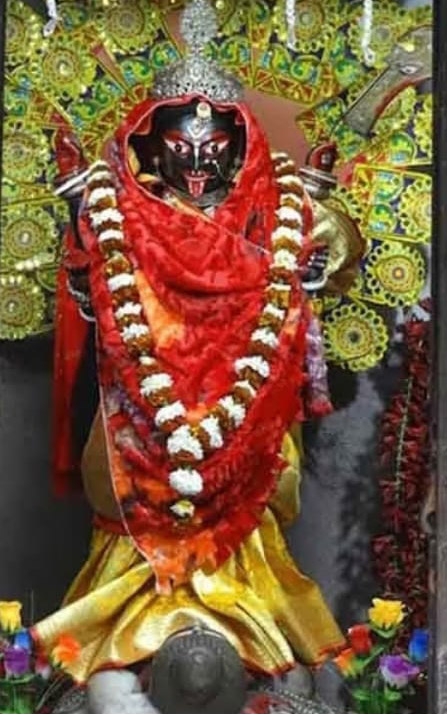Manashimaya

The ancient Bhabatarini Mandir located at Balaram Ghosh Street in Kolkata, India, is unique for several reasons:
The historical significance of the Bhabatarini Mandir lies in its association with the rich cultural and religious heritage of Kolkata (formerly Calcutta) and the broader region of Bengal. Here are some key points highlighting its historical importance:

1. Ancient Origins: The Bhabatarini Mandir is believed to have ancient origins, possibly dating back several centuries. While the exact dates of its establishment may be difficult to ascertain, its presence predates much of the modern development in Kolkata.
2. Cultural Heritage: The temple represents an integral part of Kolkata’s cultural landscape, serving as a place of worship and spiritual solace for generations of devotees. It reflects the syncretic blend of Hindu religious traditions prevalent in Bengal, particularly the worship of the goddess Bhabatarini, a form of Goddess Kali.
- Symbol of Tradition: As one of the oldest temples in Kolkata, the Bhabatarini Mandir symbolizes the continuity of religious practices and traditions passed down through generations. Its existence and continued significance serve as a link to the city’s past and heritage.
- Architectural Heritage: The temple’s architectural style, characterized by intricate carvings, terracotta artwork, and traditional Bengali design elements, represents an important aspect of Bengal’s architectural heritage. It showcases the craftsmanship and artistic skills of the artisans of its time.
- Witness to History: The Bhabatarini Mandir has likely witnessed various historical events and societal changes in Kolkata and Bengal. Its enduring presence amid urbanization and modernization serves as a reminder of Kolkata’s historical continuity and cultural resilience.
Overall, the Bhabatarini Mandir holds significance as a religious site but also as a historical and cultural landmark in Kolkata, contributing to the city’s identity and heritage.
The architectural style of the Bhabatarini Mandir on Balaram Ghosh Street reflects the traditional Bengali temple architecture prevalent in the region. Here are some key features of its architectural style:
https://www.highcpmgate.com/ek38ehj4r?key=76c0c8befd11c3ea0eac8d4a3e1ba271Terracotta Artwork: One of the defining characteristics of the temple’s architecture is its elaborate terracotta artwork. Terracotta panels depicting various mythological scenes, deities, and floral motifs adorn the temple. This intricate terracotta ornamentation is a hallmark of Bengali temple architecture and adds to the aesthetic appeal of the structural part of the temple.
Traditional Bengali Elements: The temple incorporates traditional Bengali architectural elements such as the “chala” roof, which is a curved, sloping roof often seen in Bengali temples and huts. The “ratna” style of temple architecture, characterized by a pyramidal tower with multiple tiers, may also be present in the temple’s design.

Ornate Carvings: The temple features ornate carvings on its walls, pillars, and doorways, showcasing the skilled craftsmanship of artisans from the region. These carvings typically include intricate floral patterns, geometric designs, and depictions of Hindu deities and mythological figures.
Temple Layout: The layout of the Bhabatarini Temple is likely to follow the traditional architectural principles of Hindu temple construction, with a central sanctum housing the deity, surrounded by a circumambulatory path for devotees, to perform rituals and offer prayers.
Use of Local Materials: Like many traditional temples in Bengal, the Bhabatarini Temple is constructed primarily using locally available materials such as bricks, wood, and terracotta. This use of indigenous materials reflects the region’s architectural traditions and ensures the temple’s integration with its surrounding environment.
The Bhabatarini Mandir holds significant cultural importance, particularly within Kolkata and the broader region of Bengal. Here are several aspects highlighting its cultural significance:
Religious Significance: The temple is dedicated to Bhabatarini, a form of the Hindu goddess Kali. As such, it serves as a place of pilgrimage and worship for devotees who come to seek the blessings and protection of the goddess. The temple’s rituals, ceremonies, and festivals play a central role in the religious life of the local community.
Cultural Identity: The Bhabatarini Temple is a part of Kolkata’s cultural identity, representing the city’s rich religious heritage and traditions and a symbol of Bengal’s cultural resilience and continuity, preserving ancient customs and rituals passed down through generations.
Artistic Heritage: The temple’s architectural style, characterized by its terracotta artwork, intricate carvings, and traditional Bengali design elements, represents an important aspect of Bengal’s artistic heritage. The temple’s craftsmanship and aesthetic appeal contribute to the region’s cultural legacy and artistic traditions.
Community Gathering Place: Beyond its religious significance, the Bhabatarini Mandir is a focal point for community gatherings, social events, and cultural activities. It provides a space for people to come together, celebrate festivals, and participate in religious and cultural programs, fostering a sense of community cohesion and solidarity.
Tourism and Heritage: The Bhabatarini Mandir attracts tourists, historians, and scholars interested in exploring Kolkata’s cultural and architectural heritage. Its historical significance, architectural beauty, and religious importance make it a prominent landmark and tourist destination in the city, contributing to promoting and preserving Kolkata’s cultural heritage.
Spiritual Atmosphere: Many visitors and devotees are drawn to the serene and spiritual atmosphere of the temple. It provides a tranquil space for meditation, reflection, and seeking blessings from the deity.
Preservation Efforts: Despite the passage of time and the changing urban landscape, efforts have been made to preserve the historical and architectural integrity of the Bhabatarini Mandir. These preservation efforts help maintain its unique character and ensure that future generations can appreciate its beauty and significance.
Overall, the Bhabatarini Mandir at Balaram Ghosh Street stands out as a unique cultural and architectural gem, It is a fine example of traditional Bengali temple architecture, characterized by its terracotta artwork, traditional elements, and ornate craftsmanship. The Bhabatarini Temple holds profound cultural significance as a religious, artistic, and community institution, embodying the cultural richness and diversity of Kolkata and the wider Bengal region.
